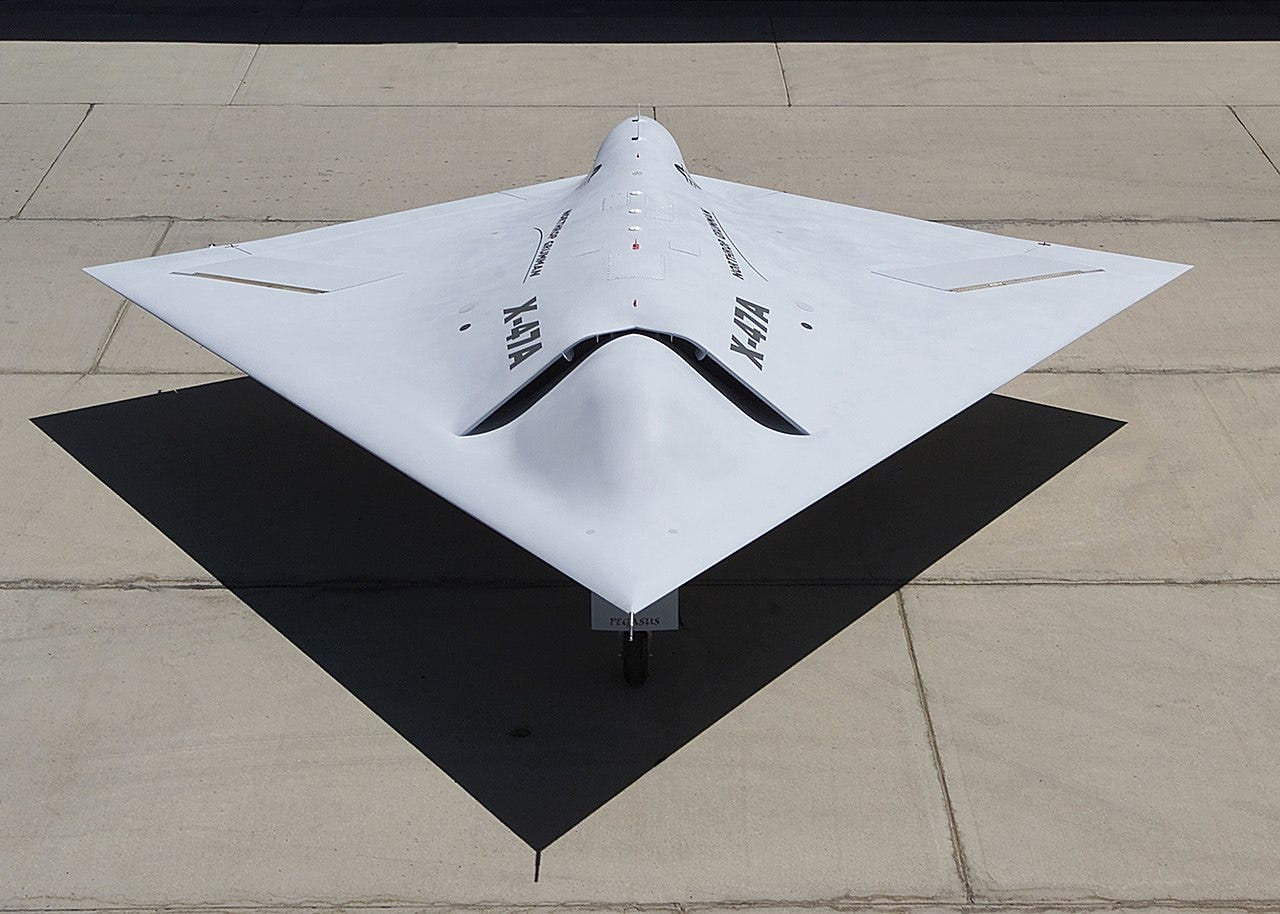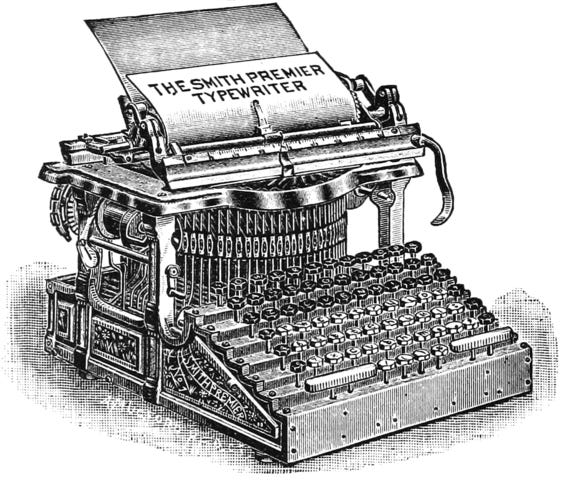Speculative Friction -- Air War: California AD 2043
In the first of a new series, I look at a fictional conflict, and what it tells us about how the author understood future war.
The US Navy’s flagship drone is an uninhabited aerial tanker. Roughly the proportions of an F/A-18 Super Hornet, if a little squatter, the MQ-25A Stingray is built as a flying fuel truck, extending the range at which carrier-borne fighters can do war by hundreds of miles. It’s a fascinating piece of tech, with a price tag to match, and it comes as the culmination of about two decades of the Navy looking for a flashy robot to fly from aircraft carriers.
The Stingray is the centerpiece of my most recent story for Popular Science, in which I try to capture 15 or so years of development and planning in about 1500 words. In the process of writing it, I discovered a weird little story about speculative war.
“Air War: California AD 2043” was a special four-page fold-out spread in the November 2003 issue of Popular Science that imagined the culmination of several ongoing trends of military acquisition, all brought to bear on a sudden breakaway rebellion in the Los Angeles area. It was written by longtime aviation journalist Bill Sweetman.
In Air War, a small blue-gray wedge flies above LAX labeled the “Unmanned Combat Air Vehicle,” (UCAV), with a note saying it is “laser-equipped for missile defense.” In the story, these stealth drones exist to blast missiles out of the sky, protecting other aircraft.
I found Air War while searching for one of the earliest instances of Navy combat drones, which all bore the original moniker UCAV. There are earlier instances in Google’s increasingly opaque PopSci archives. In 1997, Sweetman wrote “Fighters Without Pilots,” with the especially on-brand subhed “Nobody dies -- except the enemy. Remotely controlled combat planes are now being designed that fly better than any pilot.”
What makes Air War stand out from the rest is how it frames future war. Published just eight months after the United States invaded Iraq, Sweetman’s vision of a future war situates the enemy as an insurgency, but one that takes place entirely within the existing borders of not just the US, but of California.
“After 10 years of federal tax fiddling during the worst economic depression in 100 years, residents of the western United States are mad,” wrote Sweetman. “A classic California initiative, nicknamed Proposition Angry Bear, gains momentum: Voters will decide whether to secede.”
The scenario continues in a pulpy way, with one unified media underestimating the possibility of the vote succeeding, until the proposition wins 72 percent of the vote and LA-area National Guard, “with the assistance of a small cadre of local U.S. troops sympathetic to the secession cause” seize key bases and parts of L.A. This gives the insurgents access to laser weapons, hypersonic missiles, “daytime stealth fighters,” as well as scout and attack drones.

Completing the set up is a presidential order to stand down, a reference to “mini-nukes or other WFDs (weapons of focused destruction)”, and a nod to remote cyberwar support through attacks on neural implants from “graybeard anarchist hackers in the Bay Area.”
The real meat of Air War, the reason for its existence, isn’t any of that introductory montage. It’s a sandbox for an array of in-development or hinted-at future weapons, and one that the author can play around in without making any outward-facing claims about the future. This scenario is one of pure hegemonic rot, hand-waving away both nuclear arsenals and the existence of other nations to turn California’s political irregularities into a casus belli.
The war, as outlined, formally ends with a surrender just 96 hours after it started, with active fighting brought to a halt in 72 hours. The battle takes place in the sky and in space, with a couple of mentions to the actual horrors of sudden shooting war brought to bear on the ground. Casualties are mentioned in a couple places, from paramilitaries against special forces to civilians caught between firefights. There’s even a mention of smart bombs missing because they were jammed, a countermeasure spilling over into collateral damage.
Air War is deeply, deeply strange. It is, I think, largely successful in what it set out to do, which is to show how F-22s and F-35s, together with drones, satellites, the armored vehicles of Future Combat Systems, and a whole host of other technologies could be used in a war on a city.
Setting aside, even, that the most likely result of secessionist fighting in the United States is hyperlocal violence against neighbors, Air War is limited because, well, air war is limited. As the last 18 years have shown, the United States is quite capable of dropping bombs on the people, buildings, and vehicles that it intends to bomb. It is much less clear that the US is proficient in identifying the correct people, buildings, or vehicles to break an insurgency, or in making sure that bombing campaigns can even do what the Pentagon promises they can do.
Air War is a war story whose politics are an absence of politics. It is roughly as coherent as an incredibly technically savvy tabletop scenario, a war game interested in the mechanics of the tools of war.
It sidesteps nuclear war, like most fiction about war in the future that wants to focus on battles instead of apocalypses.
Mostly, in revisiting Air War I see an era of thinking about war frozen in amber. War is the thing that planes do to people, the piece suggests, and then goes on to describe in detail how those planes do that war.
I think that part is worth covering; I obviously wouldn’t be in this beat without strong feelings that public knowledge of war machines is important. And yet! The whole affair is so limited in what this war would be like for people. To experience the sudden rise and fall of an insurgency in four, really three, days? Air War isn’t just fiction, it’s a fiction of short victory that Air Forces tell to Congress as a way to secure the tools instead of decades-long fights.
In the story that prompted all of this, my survey of the history of the Stingray tanker, I found that the base from which the Stingray will fly is right on the boundaries of Air War’s rebellious California. The Stingrays are destined for the naval base at Point Mugu, just west of Malibu and just south of Ventura on the Pacific coast.
As tankers, the Stingrays will not directly author any violence. Instead, if all works as designed, the Stingrays will slot seamlessly into existing kill chains, a robotic facilitator of human-authored harm.
As I was drafting this newsletter, news broke that venture capital firm Andreessen Horowitz is leading a fundraising round for Substack. I’ve spent way too much time on twitter arguing about what this all means, so here’s my short, condensed version. Substack is a blogging and newsletter tool, which the company describes as a platform, while also maintaining a paid editorial wing through the writers it specifically pays up-front under Substack Pro.
There’s a lot of better writing on this: I think, in particular, Anne Trubek’s post analogizing Substack to a publisher and Annalee Newitz positioning of Substack’s Silicon Valley-style obfuscation of its editorial role are key. Most of this, up front, concerns how Substack chooses to extend its offer to writers, what writers it selects for up-front cash payments, and what that all means for this newsletter tool as a company.
It is that side of the business where an influx of VC money is most likely to be felt, especially given that Marc Andreessen is openly hostile to journalism as practiced, and to specific journalists for reporting on technology as an industry.
Here is what this means for readers of Wars of Future Past. Substack, as a tool I use to collect payments, takes 10% of every fee, be it monthly or annual. That money goes to its operating costs, and some of it joins all that venture capital in hiring specific writers for the paid editorial side.
If you are uncomfortable continuing to give money to this company and its editorial wing, a position I find completely reasonable, I can’t fault you for choosing to no longer subscribe to Wars of Future Past. While I’m going to continue offering paid subscriptions to this newsletter, I don’t feel particularly comfortable permanently paywalling any of my writing through it.
I may still have some pieces paywalled for a short period of time, though how long is really up to you, my delightful readers. Together with Alymay, I’ve put together a survey so I can better understand what you hope to get out of Wars of Future Past, and in turn, make this a newsletter you feel comfortable supporting with 90% of a subscriber fee.
This survey link will be open until April 30th, 2021.
I do genuinely enjoy writing these newsletters every fortnight, and I will keep writing them in some form for as long as I can sustain myself doing so.
If you’re in the mood for more free newsletters, may I recommend checking out what we’re doing over at Discontents?




